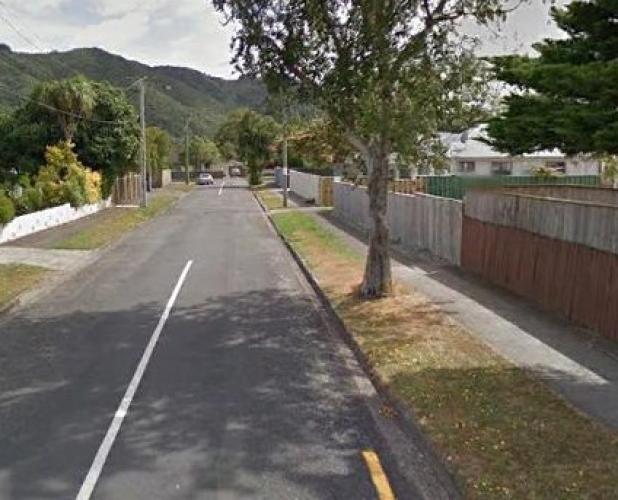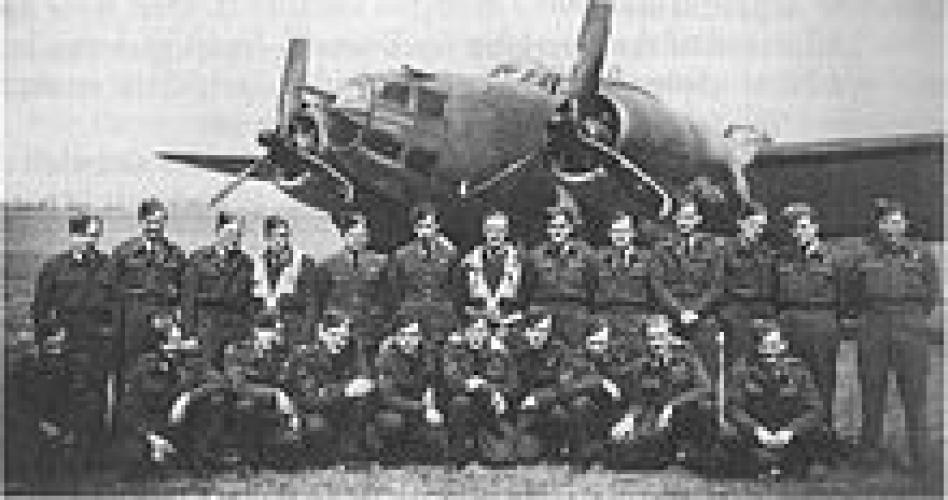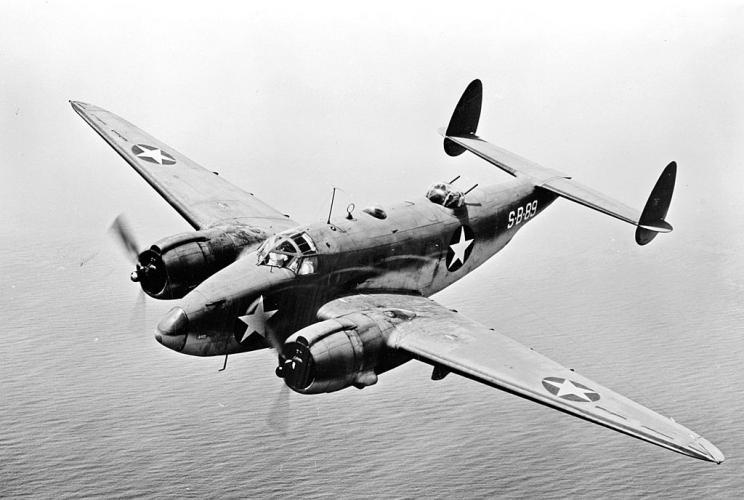130 Ventura Ave Upper Hutt, street scene 2018
Reason for the name
It was an aircraft used by the RNZAF to train New Zealand aircrew during the Second World War. It is one of four streets created as part of a 1949 subdivision whose names memorialised aircraft New Zealanders had served in during World War 2.
The Lockheed Ventura is a twin engine medium bomber of WW2, used by United States and British Commonwealth forces in several guises, including maritime patrol. The Ventura was developed from the Lockheed Model 18 Lodestar transport, as a replacement for the Lockheed Hudson bombers then in service with the Royal Air Force. Used in daylight attacks against occupied Europe, they proved to have weaknesses and were removed from bomber duty and some were used for patrols by Coastal Command.
Author: The Poppy Places Trust
The Lockheed Ventura was a medium bomber ordered for the RAF after the early success of the Lockheed Hudson. Like the earlier aircraft it was based on an existing civilian airline, in this case the Lockheed Model 18 Lodestar. This had been produced after the relative failure of the Model 14 in the civil market, and was essentially a longer version of the earlier aircraft. This allowed it to carry two extra rows of seats, making it more economical for airlines to run.
Lockheed approached the British Air Ministry in September 1939 with a proposal to produce either a maritime patrol aircraft or medium bomber based on the Model 18. Their approach could hardly have been better timed – the outbreak of the Second World War and the successful introduction into service of the Hudson meant that in February 1940 Lockheed received a contract to produce 25 of the new aircraft. In May this order was increased to 300 aircraft, powered by the 1,850hp Pratt & Whitney Double Wasp S1A4-G eighteen cylinder radial engine. By the end of the year another 375 aircraft had been ordered, bringing the total to 675.
The new Ventura was very similar in appearance to the Hudson. It was much better armed than the earlier Hudsons, with a total of eight 0.303in machine guns in early models and ten in later aircraft. Of these guns two were carried in a flexible mounting in the tip of the nose, two were fixed forward firing guns, two were placed in a ventral position near the rear of the aircraft and two (later four) in the dorsal turret. The turret was moved further forward than in the Hudson, to improve its field of fire by reducing the area blocked by the tail. The bombload was increased to 2,500lb, carried in the internal bomb bay.
The Ventura was produced by Lockheed’s Vega subsidiary. The first Ventura (of 3,028) made its maiden flight on 31 July 1941. The first production aircraft began to reach Britain in September 1941, but it would not enter combat until November 1942.
Service Career
The Ventura had a short career in its original role as a medium bomber. It entered squadron service with No.21 Squadron in May 1942, but did not enter combat until 3 November. By then No.464 (RAAF) Squadron and No.487 (RNZAF) Squadron had also received the Ventura, and on 6 December 1942 they provided forty-seven Venturas for a low level daylight raid on the Philips radio and valve factory at Eindhoven. Although the raid was a success, nine of the Venturas were lost and 37 damaged, leaving only one aircraft unscathed.
After this the aircraft switched to medium level operations, but it had entered service too late, and was already heading towards obsolescence. In May 1942 the Mosquito B. Mk IV had entered service. The “wooden wonder” could carry a very slightly smaller bombload (2,000lb compared to 2,500lb) at a much higher speed than the Ventura (385mph to 312mph) over a slightly longer range, while suffering much lower casualties. All three Ventura squadrons converted to the Mosquito FB. Mk VI during 1943 (No.487 (RNZAF) flew its last Ventura mission on 24 June, No.464 (RAAF) on 10 July 1943 and No.21 Squadron on 9 September).
After leaving Bomber Command the Ventura was sent to Coastal Command, where it replaced the Hudson in a number of squadrons No 519 and 521 Squadrons used it for weather flights, while Nos.13 and 500 used it for anti-submarine patrols over the Mediterranean. All four squadrons had replaced their Venturas by the end of 1944.
The Ventura was used by most Commonwealth air forces. The RCAF received 286 aircraft, using them to equip five maritime patrol squadrons operating from Canada. The RAAF received 75 aircraft, using then on New Guinea. The RNZAF received 139 Venturas, which saw combat over the Solomon Islands. Finally the SAAF received 169 aircraft. Initially these were used to fly anti-submarine patrols from South Africa, but by July 1944 four SAAF squadrons were serving in the Mediterranean. One of these squadrons, No 25 SAAF even used the Ventura as a medium bomber over the Balkans.
Variants
Ventura I
The first 188 aircraft were produced as the Ventura Mk I. This was powered by two 1,850hp Pratt & Whitney Double Wasp S1A4-G civil engines, could carry 2,000lb of bombs and was armed with eight machine guns. The first aircraft reached Britain in September 1941. Of the original 188 aircraft one remained in the United States as a testbed, twenty-one went to the RCAF and three crashed while being ferried across the Atlantic.
Ventura II
The Ventura Mk II saw an increase in engine power, with the installation of 2,000hp Pratt & Whitney R-2800-31 US military engines. The bomb bay was redesigned to allow the Mk II to carry 3,000lb of bombs or a 780 US gallon fuel tank. Of the 487 Mk IIs produced 196 reached Britain and the Commonwealth, 264 were taken by the USAAF and 27 went to the US Navy as the PV-3 (the designation PV-1 was reserved for US Navy production of the standard Ventura and PV-2 for an improved version with longer range).
Ventura IIA
The Ventura Mk IIA was the lend-lease version of the Mk II, powered by the same 2,000hp Pratt & Whitney R-2800-31 engines. The IIA received the USAAF designation B-34, and of the 200 ordered only 66 were delivered to British or Commonwealth countries, while the rest served with the USAAF as the B-34, B-34A and B-34B. The Ventura Mk IIA carried American guns, so the .303in guns of the original British aircraft were replaced with .50in guns – two in the nose, two in a Martin dorsal turret, two flexible guns in the nose and ventral positions and two flexible beam guns, for a total of ten guns.
Ventura III
The Mk.III designation was reserved for the O-56/ B-37 version of the Ventura, powered by Wright R-2600-13 engines. Only 18 were produced and all were retained by the USAAF.
Ventura GR.V
The Ventura GR Mk.V was the British designation for the PV1 Naval Patrol version of the aircraft. Of the 1,600 PV-1s produced 387 or 388 reached the RAF and Commonwealth air forces. The GR.Mk V used the same engines as the Ventura II, but had room for 1,607 US gallons of fuel, an increase of 263 gallons over the B-34/ Ventura II. The GR.V carried six 0.50in machine guns (two fixed forward guns, two in the dorsal turret and two in the ventral position), while the bomb bay was modified to allow it to carry six 325lb depth charges or one torpedo.
Performance (Ventura Mk.I)
Crew: 5
Engines: Pratt & Whitney Double Wasp S1A4-G
Horsepower: 1,850
Span: 65ft 6in
Length: 51ft 5in
Empty weight: 17,233lb
Loaded weight: 22,500lb
Maximum weight: 26,000lb
Maximum Speed: 312mph at 15,500ft
Cruising Speed: 272 mph
Service ceiling: 25,000ft
Range: 925 miles
Guns: eight 0.303in machine guns
Bomb load: 2,500lb
Royal New Zealand Air Force
- From August 1942, 487 Squadron RNZAF, (operating in Europe as part of the RAF), was equipped with the type, although losses (including on 3 May 1943 the loss of all 11 aircraft attacking Amsterdam), lead to their replacement with the de Havilland Mosquito in June.
- The RNZAF in the Pacific received 139 Venturas and some Harpoons from June 1943 to replace Lockheed Hudsons in the maritime patrol bomber and medium bomber roles. Initially Venturas were unpopular with the RNZAF due to rumoured poor performance on one engine, the fate of Squadron Leader Leonard Trent VC of 487 Squadron as well as the failure of the U.S. to provide NZ with promised B24 Liberators. Despite that the RNZAF Venturas came to be among the most widely used of any nations seeing substantial action until VJ Day over South West Pacific islands.
- The first 19 RB-34s that arrived by sea from the U.S. in June had much equipment either missing or damaged. Six airworthy machines were hurriedly produced by cannibalization and sent into action with No3 Squadron RNZAF in Fiji. On 26 June the first PV-1s were flown to Whenuapai and No1 Squadron RNZAF was able to convert to 18 of these by 1 August, then replacing the mixed 3 Squadron in action at Henderson Field Guadalcanal in late October.
- By this time No2 Squadron RNZAF at Ohakea and No9 Squadron RNZAF were also using the type. The following year No4 Squadron and No8 Squadron RNZAF also received Venturas. Some squadrons were retained on garrison duty while others followed the allied advance to Emirau and Green Island and to New Britain. RNZAF Venturas were tasked with routine patrols, anti-shipping strikes, minelaying, bombing and strafing missions, air/sea rescue patrols, and photographic reconnaissance missions. In an apparently bizarre case of taking Lockheed's marketing slogan of The Fighter-Bomber too literally, even briefly, Venturas conducted fighter sweeps.
- RNZAF machines often clashed with Japanese fighters, notably during an air-sea rescue patrol on Christmas Eve 1943. NZ4509 was attacked by nine Japanese single-engined fighters over St. George's Channel. It shot down three, later confirmed, and claimed two others as probables, although it suffered heavy damage in the action. The pilot, Flying Officer D. Ayson and navigator, Warrant Officer W. Williams, were awarded the DFC. The dorsal turret gunner Flight Sergeant G. Hannah was awarded the DFM.
- By late 1944 the Ventura began to be phased out of front line action as the RNZAF backed away from the Patrol Bomber concept, orders for PV-2 Harpoons were cancelled after a handful or aircraft had been delivered. At VJ Day only 30 PV-1 aircraft remained on the front-line with No. 3 Squadron at Jacquinot Bay.
- Planned re-equipment with de Havilland Mosquitos did not take place until after the cessation of hostilities. The last Ventura unit was No. 2 Squadron, which continued to operate PV-1 and PV-2 aircraft on meteorological duty until 1948. A restored RNZAF RB-34 (NZ4600) is owned by the Museum of Transport and Technology in Auckland.
- RNZAF 143 aircraft from 1943 to 1948
- No 1 Sqn RNZAF
- No 2 Sqn RNZAF
- No 3 Sqn RNZAF
- No 4 Sqn RNZAF
- No 8 Sqn RNZAF
- No 9 Sqn RNZAF
- No 487 Sqn RNZAF
- No. 1 (B) OTU
- No. 14 Servicing Unit







